12-04-2018, 01:48 AM
In between getting my property ready for the fire season and other chores, I managed to steal some more time on the frankenmill this week. I had something of a setback although it was not entirely unexpected. I discovered that the spare overarm that I have been doing the fitting work on will not fit the dovetails on the top of my mill. I knew that these machines were all individually finished by hand and components numbered and matched, but I guess I thought that it would be 'near enough for government work'. I tried to slide one of the arbor supports onto the dovetails of the spare overarm and it was just nowhere near fitting.
While this means that all the work I have been doing on the spare overarm will need to be repeated on the actual overarm from the machine, it is actually liberating in that I can now experiment on this one in the knowledge that it is sacrificial.
That being the case, I have had a fairly comprehensive re-think of how I am attacking this job. The angled fixtures that I made have been problematic in that I have not been able to hold the casting down to them as securely as I would like. I was mulling this over and thinking that maybe I could mount my two mill vices on angled fixtures and hold the overarm in both vices by the dovetail but it turns out my vices don't have sufficient jaw opening. BUT- I do have a shaper vice that has enough jaw opening to just about get the whole milling machine in.
While I was having a re-think about how to go about things, I decided it was time I had a decent size fly-cutter to mount in the NMTB40 horizontal spindle. Another spinoff project.
I found a rough chunk of unknownium plate that I had cut out with the oxy torch ages ago, turned it into a thick disc, bored a 1" hole through it, counterbored that to take a decent amount of weld, cut down a bent NMTB40 1" arbor (the one I was pathetically trying to straighten a year or so back) and stuck the two together. Once it had cooled down, I mounted it in the mill spindle and clamped a lathe tool to the table to face it again and then chamfer it. Drilled and reamed a 3/8 hole to take a round toolbit and another hole intersecting that to take a 5/16 grubscrew. I put a piece 3/8 round HSS in a mill vice plonked on the surface grinder chuck and ground a flat on one side for the grubscrew to engage on, then ground the end of it to look like my approximation of a cutting tool. Voila.
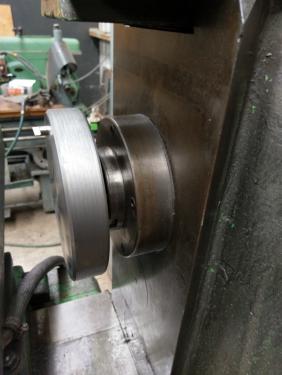
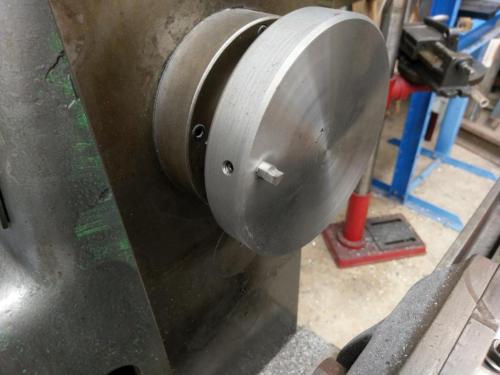
One more spinoff project complete. I have thoughts of also using this as a chuck mounting plate so I can use the horizontal arbor as a lathe and my rotary table as a ball turner. But I'm getting ahead of myself.
I set the shaper vice up on the mill (twice; the first time it was too far back to bring the work to the flycutter ) Tramming the vice with a jaw that looked like the surface of the moon was impossible, so I whipped the fixed jaw off and introduced it to the surface grinder. Not only was it rough, it was not anywhere near flat.
) Tramming the vice with a jaw that looked like the surface of the moon was impossible, so I whipped the fixed jaw off and introduced it to the surface grinder. Not only was it rough, it was not anywhere near flat.
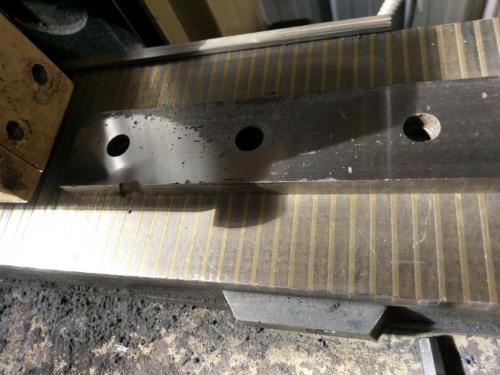
I'll need to make some new jaws for this vice some time. Later.
Using parallels on one side to get the angled side of the overarm vertical left only just enough jaw face to pick up the corner of the dovetail.
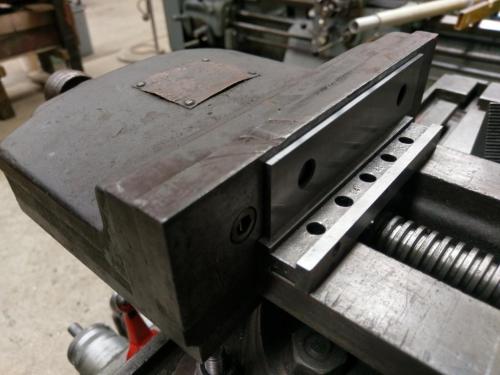
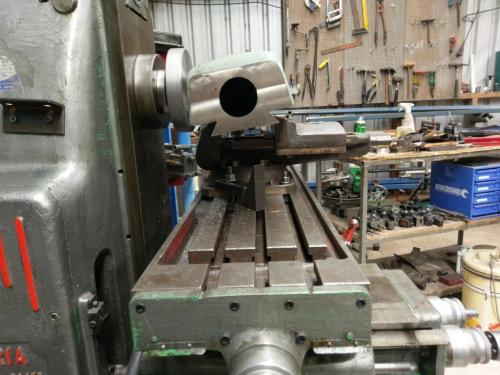
With the 48kg shaper vice and the 38kg overarm all offset to one side, I was a bit worried about tipping the mill over. That side of the base has the bit for the coolant pump sticking out, might be all that saved it. Think I'll have to support it somehow before hang it out the other side.
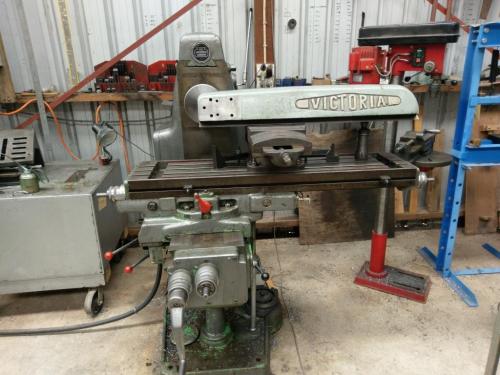
I milled the side of the casting all the way back to the 'Victoria' logo. I've got enough X travel to go a fair bit further and the setup in the vice is repeatable enough that I think I can move the casting along in the vice and mill the whole length of the overarm if need be. That is one of the things i decided to change- I don't think I have enough length back along the arm with the original setup.

I've had a couple of big forklift tines lying about for a while- I was going to use these on the rear of my tractor but I got a smaller pair that will be plenty big enough for that, so these are now a source of material.

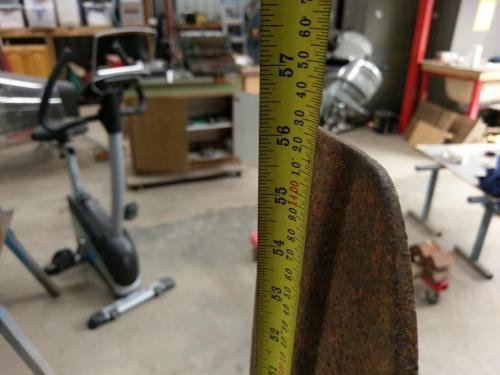
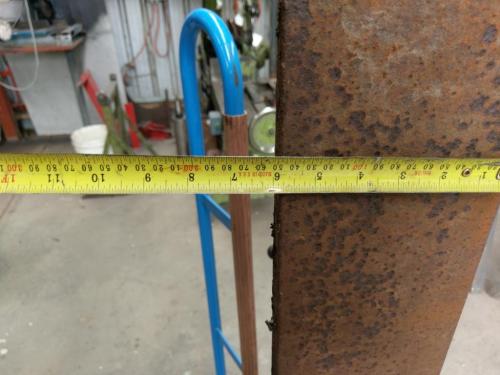

That thing weighs 88kg. I sure as heck didn't get it in the bandsaw by hand.
Cutting the tine at it's thickest point, which will provide a face at the front end of the overarm, there is enough length to go all the way to the back end of the overarm. I'm undecided whether to use the whole length. Happy to hear opinions on that.
That was all I had time for before other commitments, tomorrow is Monday for me so hopefully more next week.
While this means that all the work I have been doing on the spare overarm will need to be repeated on the actual overarm from the machine, it is actually liberating in that I can now experiment on this one in the knowledge that it is sacrificial.
That being the case, I have had a fairly comprehensive re-think of how I am attacking this job. The angled fixtures that I made have been problematic in that I have not been able to hold the casting down to them as securely as I would like. I was mulling this over and thinking that maybe I could mount my two mill vices on angled fixtures and hold the overarm in both vices by the dovetail but it turns out my vices don't have sufficient jaw opening. BUT- I do have a shaper vice that has enough jaw opening to just about get the whole milling machine in.
While I was having a re-think about how to go about things, I decided it was time I had a decent size fly-cutter to mount in the NMTB40 horizontal spindle. Another spinoff project.
I found a rough chunk of unknownium plate that I had cut out with the oxy torch ages ago, turned it into a thick disc, bored a 1" hole through it, counterbored that to take a decent amount of weld, cut down a bent NMTB40 1" arbor (the one I was pathetically trying to straighten a year or so back) and stuck the two together. Once it had cooled down, I mounted it in the mill spindle and clamped a lathe tool to the table to face it again and then chamfer it. Drilled and reamed a 3/8 hole to take a round toolbit and another hole intersecting that to take a 5/16 grubscrew. I put a piece 3/8 round HSS in a mill vice plonked on the surface grinder chuck and ground a flat on one side for the grubscrew to engage on, then ground the end of it to look like my approximation of a cutting tool. Voila.
One more spinoff project complete. I have thoughts of also using this as a chuck mounting plate so I can use the horizontal arbor as a lathe and my rotary table as a ball turner. But I'm getting ahead of myself.
I set the shaper vice up on the mill (twice; the first time it was too far back to bring the work to the flycutter
 ) Tramming the vice with a jaw that looked like the surface of the moon was impossible, so I whipped the fixed jaw off and introduced it to the surface grinder. Not only was it rough, it was not anywhere near flat.
) Tramming the vice with a jaw that looked like the surface of the moon was impossible, so I whipped the fixed jaw off and introduced it to the surface grinder. Not only was it rough, it was not anywhere near flat.I'll need to make some new jaws for this vice some time. Later.
Using parallels on one side to get the angled side of the overarm vertical left only just enough jaw face to pick up the corner of the dovetail.
With the 48kg shaper vice and the 38kg overarm all offset to one side, I was a bit worried about tipping the mill over. That side of the base has the bit for the coolant pump sticking out, might be all that saved it. Think I'll have to support it somehow before hang it out the other side.
I milled the side of the casting all the way back to the 'Victoria' logo. I've got enough X travel to go a fair bit further and the setup in the vice is repeatable enough that I think I can move the casting along in the vice and mill the whole length of the overarm if need be. That is one of the things i decided to change- I don't think I have enough length back along the arm with the original setup.
I've had a couple of big forklift tines lying about for a while- I was going to use these on the rear of my tractor but I got a smaller pair that will be plenty big enough for that, so these are now a source of material.
That thing weighs 88kg. I sure as heck didn't get it in the bandsaw by hand.
Cutting the tine at it's thickest point, which will provide a face at the front end of the overarm, there is enough length to go all the way to the back end of the overarm. I'm undecided whether to use the whole length. Happy to hear opinions on that.
That was all I had time for before other commitments, tomorrow is Monday for me so hopefully more next week.
Lathe (n); a machine tool used in the production of milling machine components.
Milling Machine (n); a machine tool used in the production of lathe components.
Milling Machine (n); a machine tool used in the production of lathe components.




